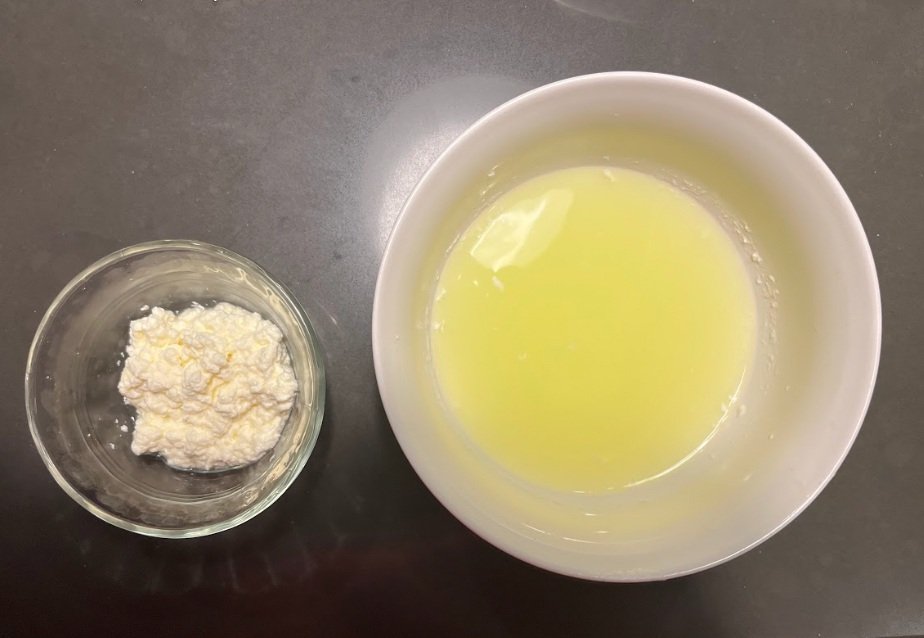Words on Curds: Homemade Ricotta in a Microwave
Author and Photographer: Olivia Rae Okun-Dubitsky
Welcome back to Words on Curds! For this next column entry, I want to talk about all things ricotta. Today, I will explain what ricotta is, how to make it in five minutes using things only from the dining hall of your choice, and my favorite three-ingredient ricotta recipe.
Firstly, what is ricotta? Ricotta was traditionally made in Italy to avoid waste. In most cheesemaking, milk is heated up, and it separates into liquid (whey) and fat (curd). These curds are then strained and pressed together, and voila–cheese! Tiny bits of curd are often left in the whey, though. In order to avoid food waste, these little bits would be reheated, which would cause them to form larger clumps. These curd-clumps are then made into ricotta. This process also explains ricotta’s meaning–ricotta means “recooked” in Italian. Nowadays, ricotta is made from whole milk instead of whey, making it commercially available and widely beloved by connoisseurs and home cooks alike.
But why buy it when you can make it? I hear you say, “Olivia Rae, cheesemaking is hard and takes practice–you said it yourself!” While this is sometimes true, I promise that you can make delicious, fluffy, and spreadable ricotta in just five minutes. It is that easy. If you want to become the most beloved person in your house or apartment, read on.
Recipe: Five-Minute Microwave Ricotta
(Inspired by food scientist Sarah Bond)
Prep Time: 2 minutes
Cook Time: 4 minutes
Serving Size: around 1 cup, but feel free to halve or double the recipe
Ingredients:
2 cups cow’s milk*
2 tbsp of either vinegar or lemon juice**
½ tsp of salt
*Any cow’s milk will do the trick; in theory, dairy-free milk will work, though the measurements might need some tweaking. The fat percentage in the milk will affect the flavor (higher fat = richer flavor), but that is a matter of personal preference... or what you have in your fridge.
**Anything with a chemical kick works: apple cider vinegar, white vinegar, lemon juice, lime juice, etc. This is what causes the enzymes to kick in and do their thing! (Their “thing” being coagulating curd.)
Instructions:
1. Add the milk to a microwave safe bowl. Microwave it for 3 to 5 minutes, depending on the strength of your microwave.
2. Add your vinegar or lemon juice to the mixture and stir gently. Let it sit uncovered and undisturbed for 1 to 2 minutes.
3. Drag a spoon through the mixture. If the mixture does not look curdled or clumpy, add another tablespoon of vinegar or lemon juice and microwave it for another 30 seconds.
Curdled Whey
4. Strain your whey. There are a couple of ways to do this. The easiest way is to simply take your washed hands (once the mixture is cool enough) and scoop out the ricotta curds, squeezing out all excess liquid. You can also use a strainer with small holes or a sturdy paper towel or dish towel. I recommend saving your whey–it is incredibly nutritious and is great in smoothies, protein shakes, you name it.
Separated Curds and Whey
5. Sprinkle in your salt and mix. Again, it is easiest with your hands, but a spoon also works.
6. Store your ricotta in the refrigerator. It stays good for up to 5 days.
What to Do With Your Ricotta:
You now have homemade, delicious ricotta. What should you do with it? Included below are two of the easiest and tastiest ricotta recipes. For the first one, I cannot, for the life of me, find a name or even any information online, and the recipe has no measurements and only three ingredients. However, it is rumored to have originated in Sicily, and ever since I had it for the first time when my boss made it for lunch on the farm, I have experienced non-stop cravings. Here are some yummy ideas:
Simply place your ricotta in a bowl, drizzle on honey, and sprinkle on some black pepper. It sounds like an odd combination, but it is a beautiful, simple dish with an attitude. Eat it with crackers, bread, or by the spoonful (shhh…I don’t judge).
2. Alternatively, your ricotta will be great schmeared on top of toast with jam, avocado, or a fried egg. It is also delicious mixed into any pasta sauce and makes an excellent addition to any cheese plate.
That is all I have for this week’s Words on Curds. Hope everyone had a gouda Thanksgiving!



